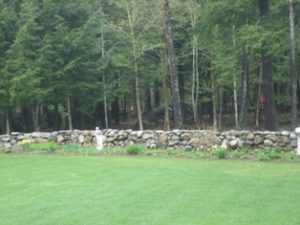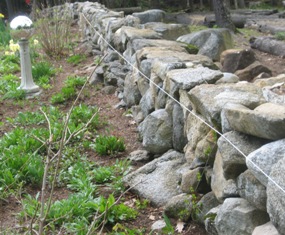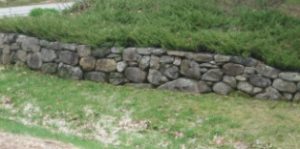The Beauty and Charm of New England Stone Walls and Tips on How to Build a Dry Stone Wall
By Mark J. Donovan
|
|
Here in New Hampshire stone walls are as ubiquitous as May Flies in spring. You can find stone walls everywhere throughout the state, as well as in the greater New England area. At one point in history, New England had approximately 250,000 miles of stone walls. They can be found in fields, in the forests, along the roads and even in backyards. Stone walls played an important role in forming property line boundaries and holding in farm animals. They also provide some history of how the surrounding and encompassing land was once used.
In an effort to farm the New Hampshire land, early settlers and farmers deforested the land to create fields. |
After clearing the trees they then had to remove the granite stones from the soil that were ubiquitous to the area. It isn’t by coincidence that New Hampshire’s nickname is “The Granite State”.
In the process of clearing the deforested land of stones farmers built stone walls. By building stone walls farmers were able to grow crops, keep the cows penned in, and establish property lines.
 |
 |
How to Build a Stone Wall (Gravity Stone Wall)
Besides their historical functional purpose, stone walls also provide a unique New England charm that many residents still like to replicate. As a result, the building of stone walls or the restoration of them continues to this day.
Learning how to build a stone wall free of mortar is fairly straight forward, however the work is grueling. Building a stone wall requires a significant amount of brute labor as the stones are extremely heavy and need to be first gathered and then put into position.
If determined to build a stone wall, or restore one, there are a few key tools you will need. Work gloves, eye protection, hammer, shovel, and a large crow bar.
If you are planning to use large boulders then a small backhoe can come in handy for digging a trench and for pushing the larger base stones in place.
| In many cases stone walls are restored, versus built from scratch. Thus a supply of stones is already available to you. If you are building a new stone wall then you will need to acquire the stones. You can either purchase pallets of stones, or collect them off of fields or old, nearby, decrepit stone walls. Collecting stones is extremely labor intensive and usually will require some motor assistance, e.g. backhoe, truck, etc.
Once you have a supply of stones, the next thing you will need to do is run a string line for the length of the proposed stone wall. Attach the ends of the strings to stakes that have been pounded into the ground. |
 |
Next, using either a backhoe or shovel dig a trench along the length of the string line that is approximately 6 inches deep and 2-3 feet wide. If you live in a deep frost area, then you may want to dig down a foot or so and add crushed stone to aid in drainage.
Also, keep in mind the width of the stone wall should be nearly the same dimension as the height of the stone wall. For example, if you are building a two foot high stone wall, the width of the stone wall should be approximately 1.5-2.0 feet wide. A wide base helps insure a structurally sound stone wall.
After digging the trench, place into the trench the largest of stones. Position each stone so that the flat or straight side of the stone is in line with your string line. Note that you may need to use small stones to shore up the large stones so that the front face of the larger stones is even with the string line.
Next, position a row of additional large stones behind the front base tier to obtain the proper width of the stone wall.
Position the second tier of stones on top of the base tier, such that the second tier overlaps the joints of the base tier. Again, position the second tier of stones so that their flattest face is positioned along the string line. Again, use small stones to help level the second tier of stones. Also, use small stones to fill in the spaces between the base and second stone tiers.
With the face side of the second tier in place, backfill the stone wall with a second row of stones. Note that as you go up in height you can narrow the width of the stone wall.
Continue the process of stacking the stones in this way until you have reached the desired height.
To cap off the stone wall, use large flat stones. Again, use smaller stones to level the flat stones so that the overall stone wall is smooth on top.
Stone walls are an excellent accessory to a backyard or a garden, so if you live in an area that is stone rich, consider putting some of them to use. Though building a stone wall requires a great deal of manual labor, it is an excellent way to add natural beauty to your yard and to your home.
Dress Up Your Home’s Exterior with an Arbor – If you’ve always wondered what to do about a side door entrance to your house or garage to make it more appealing, or just wanted to simply spice up the backyard, building an arbor may be your answer. The “How to Build an Arbor Ebook” provides detailed, step-by-step instructions and pictures on how to build an entrance-way arbor for your home. Order and Immediately Download today!. 100% Money-Back Guarantee if you are not satisfied.
Planning to have a Brick or Paver Walkway Installed by a Landscaping Contractor but not sure what questions to ask to ensure you hire the right one? See HomeAdditionPlus.com’s Brick and Paver Walkway Bid Sheet. The Brick and Paver Walkway Bid Sheet will help ensure that your walkway project goes smoothly and you get the finished walkway you are looking for.
- Types of Retaining Wall Systems
- How to Build Retaining Walls
- How to Install a Stone Paver Walkway Video
Additional Landscaping Resources from Amazon.com
 |
 |
Free Home Addition Price Quotes with No Obligation!
Fill out our 3-5 minute quick and easy form, and receive a free price quote on a house addition from one of our prescreened and licensed home addition contractors. This process is free and there is no obligation to continue once you receive your house addition price estimate.
